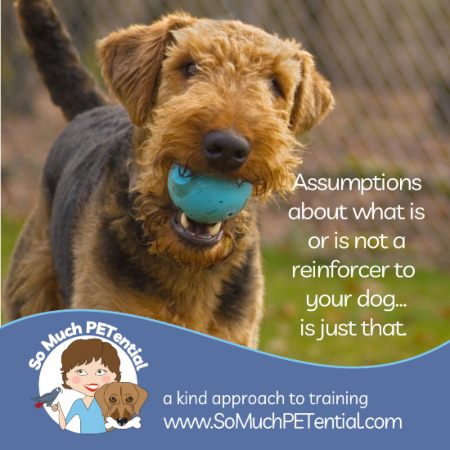If you’ve got a dog that suffers from astraphobia (yes, there really is a technical term for dog thunderstorm phobia and anxiety), you know, it can be just heart wrenching to watch.
 Often, long before that first drop of rain or sound of thunder, your dog tucks his tail down and lowers his body posture, begins pacing, breathing heavy and panting, possibly drooling, and either becomes hyper clingy or tries desperately to hide from the terrifying event that obviously (from your dog’s perspective) can cause him real bodily harm.
Often, long before that first drop of rain or sound of thunder, your dog tucks his tail down and lowers his body posture, begins pacing, breathing heavy and panting, possibly drooling, and either becomes hyper clingy or tries desperately to hide from the terrifying event that obviously (from your dog’s perspective) can cause him real bodily harm.
For dogs like that, often no amount of effort on your part will convince him that danger is not imminent. So, what is a concerned pet parent to do to reassure his/her dog that the world is not coming to an end?
It’s a common question because it is a common problem.
“It is a legitimate panic attack,” veterinary behaviorist Dr. Lisa White, DVM, told me in a conversation recently.
Causes of Thunderstorm Fear in Dogs
As with any fear, there are so many *potential* causes for thunderstorm phobia in dogs.
It could be that, in the past, the BOOM of thunder startled your dog and with repeated surprise BOOMS, that startle has escalated to an elevated heart rate and other unpleasant physical changes that have become associated with thunder. And now the predictors of thunder – change in barometric pressure, changes in wind, changes in static electricity, rain, cloudy skies, lightning, or even things that YOU do have also become predictors for those unpleasant physical changes.
Dogs with other kinds of anxiety may be more prone to experiencing a fear of thunderstorms.
It could be that something else aversive to your dog just coincidentally happened during a thunderstorm and so that has caused your dog to associate thunderstorms with bad things.
The thing is, you may never know the cause. I am frightened of big, jumpy cave crickets that occasionally find their way to my basement. I don’t know why but I am. I will scream and run out of the room if one startles me. Of course now, because I have a history of those things jumping at me completely unexpectedly, it has caused my fear to become even worse.
Anxiety and fears do not typically just go away on their own. Like anything else, they can strengthen over time with continued exposure.
What can you do to help your dog?
If your dog feels better and safer by your close proximity, and even your holding your dog, be that source of comfort for your dog. Those physical reactions in your dog are real and unpleasant and scary. You won’t be reinforcing your dog’s fear. But do not hover over or hold your dog if that causes your dog more discomfort. Some dogs may be comforted by simply your presence but may get more stressed if you try to hug them. You’ve really got to know your dog and heed what feedback your dog is giving you as to whether or not human contact is helping.
If your dog feels better in a hiding place like a closet or under a piece of furniture or in a bathroom, let your dog hang out in there to help your dog feel safe.
As for thundershirts, it may or may not help. Definitely if your dog shows stress when you have put other clothing on him in the past (like for Halloween), this is NOT the time to be trying it again. Your dog should already have a positive association with wearing something over his body before trying a thundershirt in an already stressful event.
As for using something your dog REALLY likes (like a special bone or piece of cheese) to help your dog feel better, and even teach your dog a positive association of thunderstorms, it is important to remember that, in order to work on counter conditioning the fear of storms, your dog needs to be under threshold to begin with. The tricky thing about counter conditioning to thunderstorm anxiety is that you may not always be near when the storm comes rolling in. Successful counter conditioning needs careful and consistent pairing of the stimulus with the high value food or activity. If you are away often when there is thunder, lightning, wind and rain, you won’t be able to teach your dog that the storm is always a predictor of great stuff.
Dr. White uses what she refers to as a Storm Party not only for treatment, but for diagnosis as well, to see where the dog is on the anxiety scale. She asks, “If your house is on fire and your dog could save only ONE thing, what would that be?” If the answer is CHEESE, then she would suggest for example, that the owners make a stuffed Kong with cheese. It ONLY comes out when it rains or storms. If that dog doesn’t want anything to do with the Kong in that situation, it is a sign of real life panic. Then she recommends talking to her or their vet about pharmaceuticals.
If, however, the dog says, “I am WAY more interested in that CHEESE Kong than what is going on outside,” then you know you can use that to teach a different association with the weather.
“My clients who have dogs with that extreme level of panic about storms become really good at checking the weather because those short acting anxiety medications do not help quickly but there are some medications that can last eight to 12 hours,” Dr. White said. “I’d rather have those clients give their dog the medication in advance if they won’t be home just in case it is needed, rather than not giving their dog the medication and needing it.”
And by the way, if you do go down the road of giving your dog medication, Dr. White recommends that you try it with your dog before the time that you REALLY need it to make sure there are no adverse affects from it.







